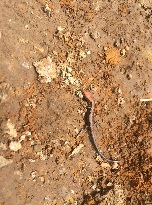Delicate Garden Skink (Lampropholis delicata)
Classification: Introduced Species Lampropholis delicata in Hawaii: Lampropholis delicata was accidentally imported to the Hawaiian islands from Australia around the 1900s via shipments of plant materials and lumber. It was noted as an unreported specimen taken on the Oahu island and identified as a Lipinia noctua at that time, then later reclassified as Lygosomoa metallicum (the metallic skink) because of its physical appearance. L. Metallicum does not occur in Hawaii, however, and is instead a misidentification of L. delicata. L. delicata are most common on the Oahu island but are also present on other islands in Hawaii, including the main island and Kauai. These lizards bear great importance in Hawaiian zoogeography because they have established high-altitude records amidst all the Hawaiian reptiles at 1220 meters on the Kauai island and 1130 meters on the main island. In fact, these lizards prefer and thrive at much higher and wetter altitudes in Hawaii and other species of lizards. Because these lizards are semi-mountainous and found in dry to wet sclerophyll forests, they are distributed throughout the dry lowland and wet upland.
The three populations of L. delicata found on the main island, Oahu, and Kauai differ with respect to their average body length and in the numbers of eggs they produce. Female lizards at a sexually mature age are larger on the big island and Kauai relative to those on Oahu. The Oahu females average about 38.6 millimeters in body length while those from the main island and Kauai average a length of 41.2 millimeters and 41.8 millimeters respectively. It is theorized that Oahu females grow to a relatively smaller body size because of their higher population densities, thus creating competition amongst individuals for food and space availability. Competition against other species might also be a possibility, and the inter and intraspecific competition experienced by Oahu females may also serve to explain the reduced egg production, as generally body size correlates to clutch size (smaller individuals with less internal body capacity lay fewer eggs than larger individuals). As such, Oahu females have a lower average number of eggs per clutch relative to the sexually mature female lizards on the main island and Kauai. Female lizards from Oahu have an average of 2.9 eggs, while the main island females average 4.7 eggs per clutch and Kauai females average 4.1 eggs per clutch.
Description: The delicate skink is more common in suburban gardens than in adjacent native bushland. It has a moderate body with a medium length, slender tail. Its scales are smooth. The back and sides are greyish-brown to rich brown, often with darker and paler flecks. A narrow yellowish-brown stripe is usually present on the outer edge of the back. The species can also have two distinct forms: a prominent white stripe and a less prominent white stripe. This dimorphism is not strictly distinguished by gender.
Habitat: This species is found in a wide variety of temperate to tropical habitats from rainforest edges, wet and dry sclerophyll forests, woodlands, coastal heaths and mangroves, where it forages among leaf-litter and other ground debris. This species is also a common garden lizard in suburban gardens and disturbed areas.
Range: Lampropholis delicata is a skink of the subfamily Lygosominae, originally from Eastern Australia. Accidentally introduced and invasive in New Zealand, Hawaii, and Lord Howe Island.
Found in these States:
HI
Diet: Lampropholis delicata can be classified as diurnal, terrestrial, arthropod feeders, and they consume a wide range of prey. L. delicata primarily consumes spiders, insects, snails, and crustaceans.
Reproduction: Although the biological mechanisms of reproductive cycles between male and female L. delicata lizards differ, they align seasonally such that mating can occur in the late summer. Typically, these lizards produce a single clutch per year of about two to four eggs.
Status: Listed as Least Concern in view of its wide distribution, there are no major threats, and because the population is stable or increasing.
»» Kingdom: Animalia - Animals
»» Phylum: Chordata - Chordates
»» Subphylum: Vertebrata - Vertebrates
»» Class: Reptilia - Reptiles
»» Order: Squamata - Lizards
»» Family: Scincidae - Skinks
»» Genus: Lampropholis
»» Species: Lampropholis delicata - Delicate Garden Skink
»» Subspecies: None
This article uses material from the Wikipedia article "Lampropholis delicata", which is released under the Creative Commons Attribution-Share-Alike License 3.0. Content may have been omitted from the original, but no content has been changed or extended.
|







